Robotization of ground forces has been of interest for the military of the world since the early last century. The development of technologies allowed implementing the idea only now. Growing military budgets in the past decade caused a landslide of artificial intellect projects and combat robots. The Izvestia writes about the current state of affairs.

MILREM Robotics TheMIS (Picture source: Army Recognition)
Scientists divide artificial intellect into three categories: Artificial Narrow Intelligence (ANI), Artificial General Intelligence (AGI) and Artificial Super Intelligence (ASI). ANI is a technology with strictly limited parameters which can operate in specific conditions. AGI is compared to humans and ASI is superior to them. Most available military and civilian artificial intelligence technologies are ANI. The first AGI development is expected in 2040s. It will take a century for ASI to appear.
At present, the artificial intellect is related to data collection, storage and processing. Brigadier General Matthew Isler in charge of artificial intellect in the US army said at AUSA 2019 conference the main aspect of artificial intelligence is to provide data in a convenient form for research centers, industry and troops.
Therefore, most projects deal with reconnaissance (including drones), sensors and situation awareness, i.e. everything to collect information. Work is also ongoing to decrease cognitive load. The information has to be sorted and rationed for each soldier so that he does not get confused.
Numerous options are offered ranging from target identification in the general database at a speed inaccessible for a human being to laying safe routes for hardware columns on the basis of available tactical information.
Robotic projects also aim to decrease the risk for a soldier on the battlefield and simplify his everyday activities in the rear. Logistical experiments are most active. In particular, automatic trucks with the master-slave function are undergoing trials. A large-scale demonstration of possibilities of robotized supply columns is expected in 2020.
At a lower level, units obtain universal transport-combat platforms like GDLS’ MUTT, Rheimetall’s Mission Master UGV or MILREM THeMIS. Specific attention is paid to supplies of the units operating in hard-of-access areas and restricted conditions (cities, jungles, mountains, etc.) where such vehicles are irreplaceable.
Another guideline concerns risky missions. Current engineering robots will be complemented by machines capable of operating in nuclear, chemical and biological contamination, as well as assault robots. The latter are likely to be small automatic options of engineering obstacle-clearing vehicles like the US M1150 Assault Breacher Vehicle (ABV) or Russian IMR-3.
Another guideline includes expensive and monotonous activity. The military want to partially or completely drop such works, as loading and unloading, ammunition delivery, earth works and construction.
Combined teams of humans and robots or Manned-Unmanned Teams (MUM-T) occupy a specific place in future plans. The concept has been designed since 1997 for the army aviation, but is completely new for the ground forces.
© Copyright 2019 TASS / Army Recognition Group SPRL. All rights reserved. This material may not be published, broadcast, rewritten or redistributed.















